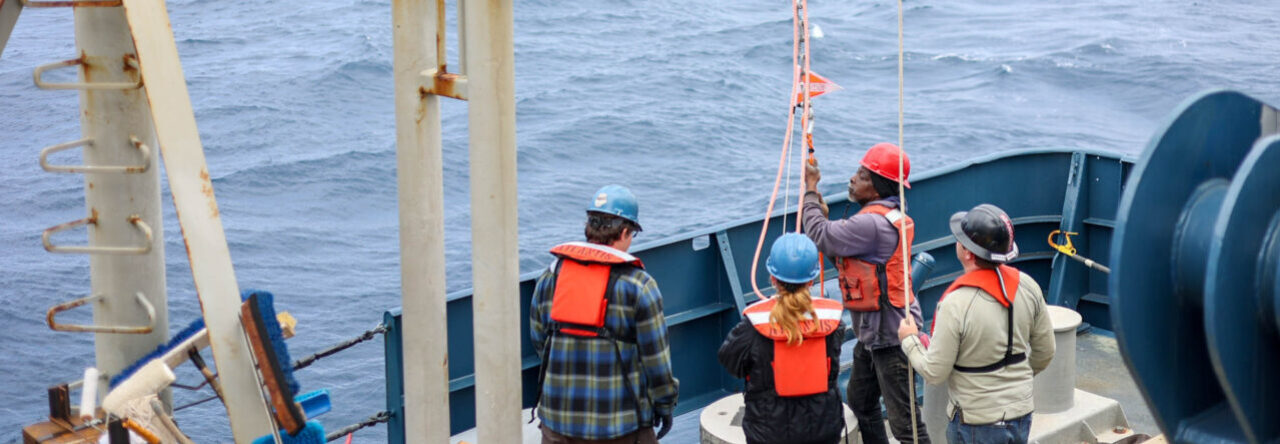Howdy all and welcome back,
Apologies for the later post, but the good news is there’s a lot to catch up on! We’re two weeks into the SPOC cruise and currently en route to 20° S Latitude. Since the start, we’ve been conducting various operations, including underway CTD (uCTD) deployments, ARGO float deployments, “short station” CTD casts, and “long station” array/CTD deployments. Our ultimate goal is to collect diverse data in the South Pacific, a critically understudied region, as we steam to 30° S. This data will primarily focus on understanding the rates and mechanisms of primary production and respiration in this area.
During transit between our five long stations, we’ve been using the uCTD to survey the surface 400 meters of ocean. This operation involves deploying a probe from the ship’s stern, equipped with sensors measuring dissolved oxygen, fluorescence, conductivity, temperature, and depth. The beauty of the uCTD is that we can continue cruising at 8 knots while collecting data on both the downcast and upcast. We’ve also been utilizing the Kilo Moana’s underway seawater flowthrough system to sample and analyze surface ocean water. Sprinkled in with these activities are Argo float deployments, contributing to an international ocean monitoring initiative that uses autonomous floats to create hydrographic profiles of the upper 2000 meters of the world’s oceans.
When not transiting, we’re on station performing CTD casts and free-floating array deployments. Before crossing the equator, we focused on performing short station CTD casts as weather was too variable and currents too strong to deploy the arrays necessary for a long station. These short stations lasted about an hour, and after we finished collecting our samples/data, we were underway again, so these stations were fast and furious.
We officially crossed the equator on Halloween, which was a happy surprise! Of course, everyone dressed up in costumes (yours truly was a hero in a half shell), and we had a full equator crossing ceremony for the “polliwogs,” aka sailors who are crossing the equator for the first time. My given wog name was Richard Simmons’ Baby goes to sea. This ceremony involved proving our skill to the Court of Neptune in the form of a talent show (I did a skit with two of my fellow wogs) and if we displeased the court with our skills we were forced to fight the spirit of a sea monster (a pinata). Overall, it was a blast of a Halloween full of karaoke, candy, and dancing.
Shortly after crossing the equator the real work of the cruise began as we started to hit our first long stations. When we arrive at these stations, we deploy multiple arrays and run 24-hour operations for the next two and a half days. We deploy a sediment trap array, a primary production/gas fixation array, and a wirewalker array with each long station. The sediment trap array uses a series of tubes with formalin/brine in the bottom to capture and hold marine snow particles, aka sediments, that sink from the surface ocean. The primary production/gas fixation array uses C-14 enrinched seawater samples (collected on station) to determine the rate of primary production. The wirewalker array uses an ingenious design involving locking cams, positive buoyancy, and wave action to collect multiple sensor profiles from the surface ocean. Our latest wirewalker casts have produced ~120 profiles from each station (which is a lot). Array deployments and recoveries are some of the most exciting operations we’re doing on this cruise, as they involve a lot of coordinated deck work, and recoveries are conducted by grappling the arrays with grappling hooks! In addition to assisting with array deployments and recoveries, one of my responsibilities is managing CTD operations. This involves maintaining the senor suite aboard the rosette, downloading/processing data, and working with OTG techs/ship crew to collect water samples from different depths. Some of the new sensors I’ve been able to work with include a Underwater Vision Profiler (UVP) and a Laser In-Situ Scattering and Transmissometry (LISST) instrument. The UVP photographs small particles within a set volume of water and the LISST uses lazer diffraction to measure the size and quantitiy of suspeneded particles!
So far, we’ve hit long stations at 5°, 10°, and 15°, and besides minor issues with equipment and sample collection, the cruise has been going smoothly. This has been one of the most involved cruises I’ve ever participated in with nonstop ~80 hour work weeks but its been incredibly rewarding and I’ve had the oppourtinity to learn a lot. I’m now appreciating the importance of time management on long cruises like this, as it can be challenging to get enough sleep, eat well, exercise, and still have a strong attention to detail for 12-hour shifts. We have two more stations to hit before we can begin heading to Tahitit and the OTG techs, ships crew, and science team have all been working hard to collect this one of a kind data! By the time we finish up our last long station I’ll have my next blog post up so stay tuned!
Until then,
Hunter
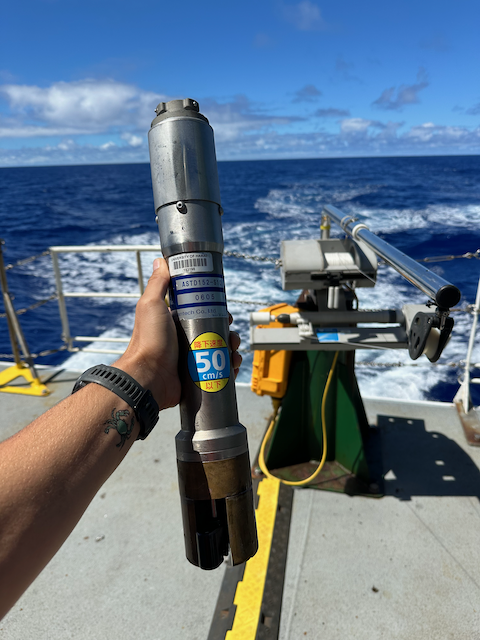
– The underwater CTD and its “reel”
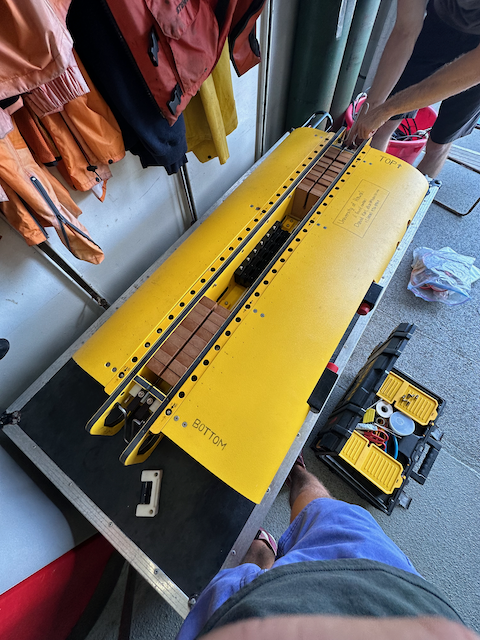
– The wirewalker. Inside the yellow covers there is a suite of sensors that measures the physical and optical properties of the water column.
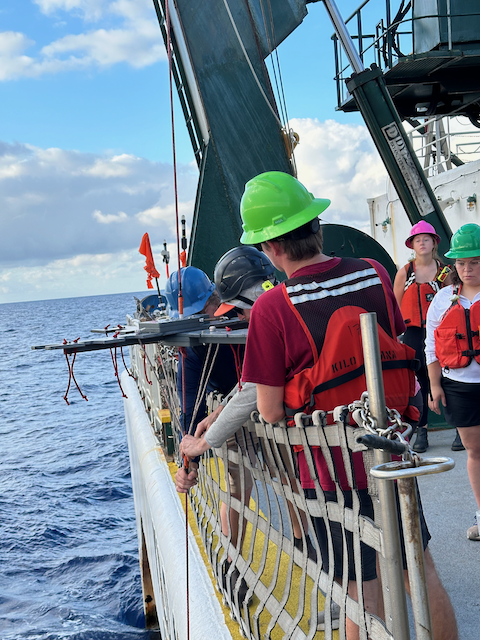
– The sediment trap holder being added to the array line

– Crossing the equator on Halloween!
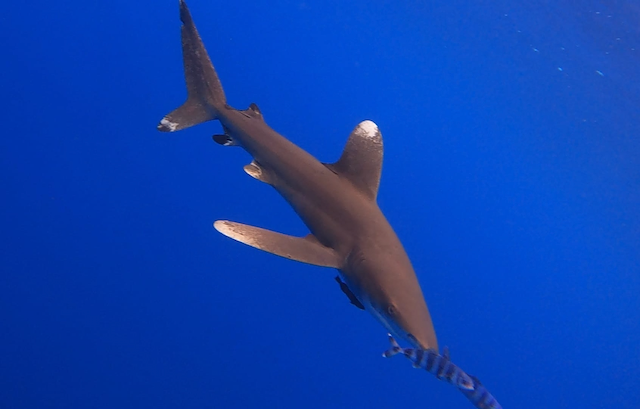
– One of many oceanic white tip sharks we’ve seen since stopping at long stations. Photo credit to one of the Kilo Moana’s ABs Stephanie for capturing this image with a GoPro on a string!

